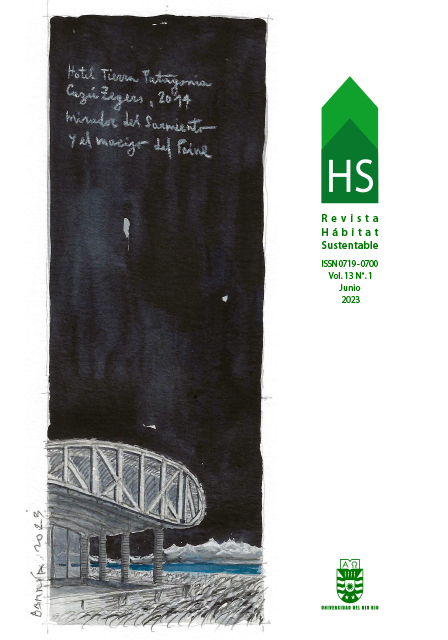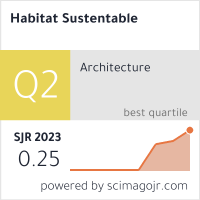Estrategias de sostenibilidad enfocadas al confort térmico y la energia incorporada de una vivienda emergente en la Región Andina del Ecuador
DOI:
https://doi.org/10.22320/07190700.2023.13.01.04Palabras clave:
masa térmica, habitabilidad, eco-arquitecturaResumen
Ante los constantes desastres naturales de regiones andinas de Ecuador, se han planteado varias soluciones habitacionales, sin embargo, estas no consideran el confort térmico del usuario ni el impacto ambiental que generan. Esta investigación aborda esta problemática desde una perspectiva bioclimática a través de un modelo de vivienda emergente en un clima andino orientado a asegurar el confort térmico y reducir el impacto ambiental de la construcción. El análisis se enfoca en la temperatura interior y la Energía Incorporada Total (EIT) del modelo de vivienda. La metodología se divide en la definición del modelo y las estrategias, por un lado y, por el otro, el análisis de estos parámetros a través de simulaciones y cálculos. Además, se realiza un análisis comparativo con otros estudios. Las estrategias definidas fueron la captación solar, masa térmica, compacidad, materiales locales-reciclados y la modulación. Los resultados muestran que el modelo planteado alcanza, de manera pasiva, las temperaturas de confort y la EIT (2135.38 MJ/m2) es menor que la de otras viviendas de carácter social.
Descargas
Citas
ÁLVAREZ, M. & AVILÉS, J. (2012). Ceniza Volcánica: Un nuevo Agente de Contaminación Química. Unidad de Preparación para desastres Químicos, Ministerio de Salud Pública, 5.
ANDERSEN, M., DISCOLI, C. A., VIEGAS, G. M. & MARTINI, I. (2017). Monitoreo energético y estrategias de RETROFIT para viviendas sociales en clima frío. Hábitat Sustentable, 7(2), 50-63. DOI: https://doi.org/10.22320/07190700.2017.07.02.05
ARSLAN, H. (2007). Re-design, re-use and recycle of temporary houses. Building and Environment, 42(1), 400-406. DOI: https://doi.org/10.1016/j.buildenv.2005.07.032
ARSLAN, H. & COSGUN, N. (2008). Reuse and recycle potentials of the temporary houses after occupancy: Example of Duzce, Turkey. Building and Environment, 43(5), 702-709. DOI: https://doi.org/10.1016/j.buildenv.2007.01.051
AZARI, R. & ABBASABADI, N. (2018). Embodied energy of buildings: A review of data, methods, challenges, and research trends. Energy and Buildings, 168, 225–235. DOI: https://doi.org/10.1016/j.enbuild.2018.03.003
CLIMATE CONSULTANT. (2021). Climate consultant software (6.0.15). Windows. Informe technologies.
CLIMATE.ONEBUILDING.ORG (2020). Repository of free climate data for building performance simulation. Recuperado de: https://climate.onebuilding.org/WMO_Region_3_South_America/ECU_Ecuador/index.html
CURADO, A. & DE FREITAS, V.P. (2019). Influence of thermal insulation of facades on the performance of retrofitted social housing buildings in Southern European countries. Sustainable Cities and Society, 48, 101534. DOI: https://doi.org/10.1016/j.scs.2019.101534
DABAIEH, M. & SERAGELDIN, A. A. (2020). Earth air heat exchanger, Trombe wall and green wall for passive heating and cooling in premium passive refugee house in Sweden. Energy Conversion and Management, 209, 112555. DOI:
https://doi.org/10.1016/j.enconman.2020.112555
DA CASA MARTÍN, F., CELIS D’AMICO, F. & ECHEVERRÍA VALIENTE, E. (2019). Metodología para elaborar una cartografía regional y aplicar estrategias bioclimáticas según la Carta de Givoni. Hábitat Sustentable, 9(2), 52-63. DOI: https://doi.org/10.22320/07190700.2019.09.02.05
DESIGNBUILDER (2016). DesignBuilder+EnergyPlus software (4.5.0.148). UK: DesignBuilder.
Dirección de Monitoreo de Eventos Adversos (2023). SitRep No.18-Deslizamiento Casual-Alausí: Informe de situación Nacional. Recuperdo de: https://www.gestionderiesgos.gob.ec/informes-de-situacion-actual-por-eventos-adversosecuador/
ECUAPLASTIC. (2021). Ecopak. Cubiertas y tableros ecológicos_Greentec. Recuperado de: https://ecuaplastic.com/index.php/productos/ecopak/14-productos/ecopak/71-greentec
EDIMCA. (2021). Sección de productos Edimca. Recuperado de: https://edimca.com.ec/productos-y-herrajes-de-madera.html
ESPINOSA, C. F. & CORTÉS, A. (2015). Confort higro-térmico en vivienda social y la percepción del habitante. Revista INVI, 30(85), 227-242. DOI: http://dx.doi.org/10.4067/S0718-83582015000300008
FONSECA-RODRÍGUEZ, O., SHERIDAN, S., HÄGGSTRÖM, E. & SCHUMANN, B. (2021). Effect of extreme hot and cold weather on cause-specific hospitalizations in Sweden: A time series analysis. Environmental Research, 193, 110535. DOI:
https://doi.org/10.1016/j.envres.2020.110535
GARCÍA MITJANS, S. M. (2022). Influencia de la tipología edificatoria y la morfología urbana en la demanda energética de la vivienda plurifamiliar en Barcelona [Projecte Final de Màster Oficial]. UPC, Escola Tècnica Superior d'Arquitectura de Barcelona. Recuperado de: http://hdl.handle.net/2117/375334
GIVONI, B. (1969). Climate and architecture. Amsterdam; London; New York: Ed. Elsevier.
GONZÁLEZ STUMPF, M. A., KULAKOWSKI, M. P., BREITENBACH, L. G. & KIRCH, F. (2014). A case study about embodied energy in concrete and structural masonry buildings. Revista de la Construcción, 13(2), 9–14. DOI: https://doi.org/10.4067/s0718-915x2014000200001
GULLBREKKEN, L., GRYNNING, S. & GAARDER, J. E. (2019). Thermal Performance of Insulated Constructions—Experimental Studies. Buildings, 9(2), 49. DOI: https://doi.org/10.3390/buildings9020049
HAMMOND, G. & JONES, C. (2008). Inventory of carbon & energy [ICE] Version 1.6a. Recuperado de: https://perigordvacance.typepad.com/files/inventoryofcarbonandenergy.pdf
HONG, Y. (2016). A study on the condition of temporary housing following disasters: Focus on container houses. Frontiers of Architectural Research, 6(3), 374-383. DOI: https://doi.org/10.1016/j.foar.2017.04.005
HUGHES, C., NATARAJAN, S., LIU, C., CHUNG, W. J. & HERRERA, M. (2019). Winter thermal comfort and health in the elderly. Energy Policy, 134, 110954. DOI: https://doi.org/10.1016/j.enpol.2019.110954
Instituto Nacional de Meteorología e Hidrología de la República del Ecuador [INAMHI]. (2017). Anuario meteorológico No 53-2013 (J. Olmedo, Ed.). Recuperado de: https://www.inamhi.gob.ec/docum_institucion/anuarios/meteorologicos/Am_2013.pdf
IWATA, T., HARADA, E. & MALY, E. (2023). Towards improving provision of wooden temporary housing: Analysis of repairs of temporary housing built by local contractors after the Great East Japan Earthquake. International Journal of Disaster Risk Reduction, 86, 103537. DOI: https://doi.org/10.1016/j.ijdrr.2023.103537
LINES, R., FAURE WALKER, J.P. & YORE, R. (2022). Progression through emergency and temporary shelter, transitional housing and permanent housing: A longitudinal case study from the 2018 Lombok earthquake Indonesia. International Journal of Disaster Risk Reduction, 75, 102959. DOI: https://doi.org/10.1016/j.ijdrr.2022.102959
KOEZJAKOV, A., URGE-VORSATZ, D., CRIJNS-GRAUS, W. & VAN DEN BROEK, M. (2018). The relationship between operational energy demand and embodied energy in Dutch residential buildings. Energy and Buildings, 165, 233–245. DOI: https://doi.org/10.1016/j.enbuild.2018.01.036
KUMAR, P. P., VENKATRAJ, V. & DIXIT, M. K. (2022). Evaluating the temporal representativeness of embodied energy data: A case study of higher education buildings. Energy and Buildings, 254, 111596. DOI: https://doi.org/10.1016/j.enbuild.2021.111596
MACIAS, J., ITURBURU, L., RODRIGUEZ, C., AGDAS, D., BOERO, A. & SORIANO, G. (2017). Embodied and operational energy assessment of different construction methods employed on social interest dwellings in Ecuador. Energy and Buildings, 151, 107-120. DOI: https://doi.org/10.1016/j.enbuild.2017.06.016
MAROCCO, R., & WINTER, T. (1997). Bosquejo de la evolución geodinámica del Ecuador. En Alain Winckell (Ed.), Geografía básica del Ecuador : 4. Geografía física : 1. Las condiciones del medio natural : los paisajes naturales del Ecuador, 15–52. CEDIG. Recuperado de: https://horizon.documentation.ird.fr/exl-doc/pleins_textes/divers16-09/010022382.pdf
Ministerio de Desarrollo Urbano y Vivienda (2011). Eficiencia energética en la construcción en Ecuador. Norma Ecuatoriana de La Construcción NEC-11.
O´HEGARLY, R., KINNANE, O., LENNON, D. & COLCLOUGH, S. (2021). In-situ U-value monitoring of highly insulated building envelopes: Review and experimental investigation. Energy and Buildings, 252, 111447. DOI: https://doi.org/10.1016/j.enbuild.2021.111447
RODRÍGUEZ RUIZ, J. L., CASTAÑEDA HERNÁNDEZ, C. G., CRUZ LÓPEZ, R. & NERIA HERNÁNDEZ, R. (2021). Diseño de un módulo de bahareque autoconstructivo de bajo costo e impacto ambiental para viviendas unifamiliares. Revista RedCA, 3(9), 158-181. DOI: https://doi.org/10.36677/redca.v3i9.15866
SANTANA OLIVEIRA, B., TORRES-QUEZADA, J., COCH, H. & ISALGUE, A. (2022). Monitoring and Calculation Study in Mediterranean Residential Spaces: Thermal Performance Comparison for the Winter Season. Buildings, 12(3), 325. DOI: https://doi.org/10.3390/buildings12030325
Secretaría de Gestión de Riesgos. (2018). Plan nacional de respuesta ante desastres. Recuperado de:
SHUKLA, A., TIWARI, G. N. & SODHA, M. S. (2009). Embodied Energy analysis of adobe house. Renewable Energy, 34(3), 775-761. DOI: https://doi.org/10.1016/j.renene.2008.04.002
SINOHARA, N., TOKUMARA, M., KAZAMA, M., YONEMOTO, Y., YOSHIOKA, M., KAGI, N., HASEGAWA, K., YOSHINO, H. & YANAGI, U. (2014). Indoor air quality and thermal comfort in temporary houses occupied after the Great East Japan Earthquake. Indoor air, 24(4), 425-437. DOI: https://doi.org/10.1111/ina.12082
TECHO. (2020). Techo Memoria 2020. Recuperado de: https://techo.org/wp-content/uploads/2021/11/TECHO-MEMORIA-2020-2_compressed.pdf
TECNICGLASS. (2021). Tecniglass. Solutions for Glazing and Glass Industry: Cuanto pesa un Vidrio - Formula para calcular el peso de un vidrio. Recuperdo de: https://tecnicglass.com/consejos/cuanto-pesa-un-vidrio/
THONIPARA, A., RUNST, P., OCHSNER, C. & BIZER, K. (2019). Energy efficiency of residential buildings in the European Union—An exploratory analysis of cross-country consumption patterns. Energy Policy, 129, 1156–1167. DOI:
https://doi.org/10.1016/j.enpol.2019.03.003
THORMARK, C. (2002). A low energy building in a life cycle—its embodied energy, energy need for operation and recycling potential. Building and Environment, 37(4), 429-435. DOI: https://doi.org/10.1016/s0360-1323(01)00033-6
TORRES-QUEZADA, J., COCH, H. & ISALGUÉ, A. (2019). Assessment of the reflectivity and emissivity impact on light metal roofs thermal behaviour, in warm and humid climate. Energy and Buildings, 188-189, 200-208. DOI: https://doi.org/10.1016/j.enbuild.2019.02.022
TORRES-QUEZADA, J. COCH ROURA, H., ISALGUÉ BUXEDA, A. & LÓPEZ BESORA, J. (2018). The roof Impact on the heat balance of low height buildings at low latitudes. PLEA 2018: Smart and Healthy Within the Two-Degree Limit: proceedings of the 34th International Conference on Passive and Low Energy Architecture: Dec 10-12, 2018 Hong Kong, China (pp. 937–938). The Chinese University of Hong Kong. Recuperado de: http://hdl.handle.net/2117/129130
TORRES-QUEZADA, J. & TORRES-AVILÉS, A. (2023a). The Construction Evolution and Their Energectic Impact in Andean Region Buildings. En Energetic Characterization of Building Evolution, 1-48. Springer Science+Business Media. Recuperado de: https://doi.org/10.1007/978-3-031-21598-8_1
TORRES-QUEZADA, J. & TORRES-AVILÉS, A. (2023b). The Constructive Evolution of the Envelope. The Impact on Indoor Thermal Conditions in Andean Regions. En Energetic Characterization of Building Evolution, 49-77. Springer Science+Business Media. Recuperado de: https://link.springer.com/chapter/10.1007/978-3-031-21598-8_2
TORRES-QUEZADA, J., TORRES, A., ISALGUÉ, A. & PAGES-RAMON, A. (2022). The evolution of embodied energy in andean residential buildings. Methodology applied to Cuenca-Ecuador. Energy and Buildings, 259, 111858. DOI: https://doi.org/10.1016/j.enbuild.2022.111858
VÁZQUEZ ESPÍ, M. (2001). Construcción e impacto sobre el ambiente: el caso de la tierra y otros materiales. Informes de la Construcción, 52(471), 29-43. DOI: https://doi.org/10.3989/ic.2001.v52.i471.681
YÉPEZ TAMBACO, D. A. (2012). Análisis de la arquitectura vernácula del Ecuador: Propuestas de una arquitectura contemporánea sustentable. [Tesis de máster]. Universidad Politécnica de Catalunya. Recuperado de: https://www.academia.edu/29898709/An%C3%A1lisis_de_la_arquitectura_vern%C3%A1cula_del_Ecuador_Propuestas_de_una_arquitectura_contempor%C3%A1nea_sustentable
ZEVALLOS, O. (1994). Lecciones del deslizamiento”La Josefina”-Ecuador. En Conferencia Interamericana sobre reducción de los desastres naturales. Cattegena de Indias, Colombia. Recuperado de: https://www.eird.org/deslizamientos/pdf/spa/doc5089/doc5089.htm
ZHOU, B., WEI, P., TAN, M., XU, Y., DING, L., MAO, X., ZHAO, Y. & KOSONEN, R. (2019). Capture efficiency and thermal comfort in Chinese residential kitchen with push-pull ventilation system in winter-a field study. Building and Environment, 149, 182-195. DOI: https://doi.org/10.1016/j.buildenv.2018.12.017
Descargas
Publicado
Cómo citar
Número
Sección
Licencia
Derechos de autor 2023 Jefferson Torres-Quezada, Santiago Lituma Saetama

Esta obra está bajo una licencia internacional Creative Commons Atribución-CompartirIgual 4.0.
El contenido de los artículos que se publican en cada número de Hábitat Sustentable, es responsabilidad exclusiva de los autores y no representan necesariamente el pensamiento ni comprometen la opinión de la Universidad del Bío-Bío.
Los autores/as conservarán sus derechos de autor y garantizarán a la revista el derecho de primera publicación de su obra, el cuál estará simultáneamente sujeto a la Licencia de Reconocimiento de Creative Commons CC BY-SA que permite a otros compartir-copiar, transformar o crear nuevo material a partir de esta obra con fines no comerciales, siempre y cuando se reconozcan la autoría y la primera publicación en esta revista, y sus nuevas creaciones estén bajo una licencia con los mismos términos.











 Programa de Información Científica/Concurso Fondos de Publicación de Revistas Científicas 2018/ Proyecto Mejoramiento de Visibilidad de Revistas UBB (Código:FP180007)
Programa de Información Científica/Concurso Fondos de Publicación de Revistas Científicas 2018/ Proyecto Mejoramiento de Visibilidad de Revistas UBB (Código:FP180007) 





